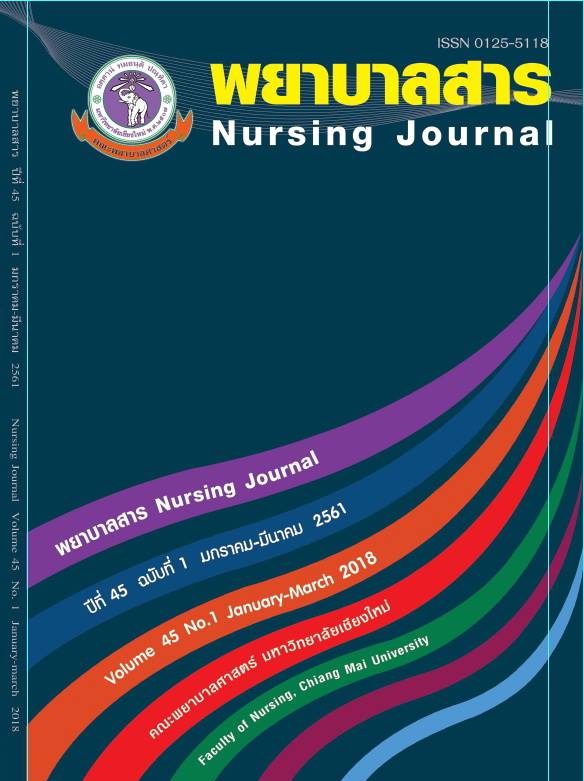Relationship Between Perceptions of Intrapartum Care Process, Childbirth Experience Perception And Satisfaction With Nursing Care Among Parturients
Keywords:
perceptions of intrapartum care process, childbirth experience perception, satisfaction with nursing careAbstract
Intrapartum care process is crucial because it affects women during labor, both physically and mentally. Smooth and safe delivery increases maternal satisfaction. This descriptive research aimed to study the structure, process and outcomes of care during labor, and the relationship between perceptions of intrapartum care process and outcomes. The purposive sample of 359 postpartum women, who delivered at Pathumthani hospital from December 2015 through August 2016 were recruited. The instruments used for data collection were: 1) demographic information record; 2) “the Perception of Intrapartum Care Process” questionnaire, developed by the researchers; 3) “the Perception of Childbirth Experience” questionnaire, modified version adapted from Manee Junsopa et al. (2012); and 4) “Satisfaction with Nursing Care” scale. The content validity index (CVI) for “the Perception of Intrapartum Care Process” and “the Perception of Childbirth Experience” questionnaires were 1.00. Reliability for the questionnaires, tested by Cronbach's alpha coefficient, were 0.86 and 0.81, respectively. Data were analyzed using descriptive statistics and Spearman's correlation. The study revealed that for the structure, the average age of nurses was 38.43 years old, with average years of experience in delivery unit was 15.14 years. Most of them (85.7%) hold a bachelor degree, 78.6% reported in good health. Structure of the parturient revealed average years of age was 25.70 years old, with the majority of them (64.3%) were between 20-34 years old, 61.6% had secondary education graduates, 50.7% were employed, 67.4% had previous childbirth experience, and 57.9% were not receiving childbirth classes before. For the process, the study found on average, parturients' perception of the intrapartum care process were at moderate level ( =56.56, SD=15.42). For the outcomes, parturients perceived their childbirth experience as positive ( =75.35, SD = 10.42) and satisfied with nursing care at moderate level ( =6.86, SD = 2.10). The perceptions of intrapartum care process had significant positive correlated with childbirth experience perception and satisfaction with nursing care (p <0.001). The findings from this study suggests that development of intrapartum care process for each phase of labor is needed to ensure positive childbirth experiences and satisfaction with nursing care, especially to promote early bonding after childbirth. Providing information about newborn and caring guidelines, including proper pain management during labor can increase the quality of the childbirth services.
References
มาณี จันทร์โสภา, ฉวี เบาทรวง และสุกัญญา ปริสัญญกุล. (2555). ผลของการสนับสนุนทางสังคมต่อความเจ็บปวดในการคลอดและการรับรู้ประสบการณ์การคลอดของผู้คลอดวัยรุ่นครรภ์แรก. พยาบาลสาร, 39(4), 71-84.
สภาการพยาบาล. (2548). มาตรฐานบริการการพยาบาลและการผดุงครรภ์ระดับทุติยภูมิและระดับตติยภูมิ. ราชกิจจานุเบกษา. เล่ม 122 ตอนที่ 94 ง. หน้า 42.
สมจิต หนุเจริญกุล, นุชนาฏ แจ้งสว่าง และสุภามาศ ผาติประจักษ์. (2553). ผลลัพธ์และการประเมินผลลัพธ์ของผู้ปฏิบัติการพยาบาลขั้นสูง. ใน สมจิต หนุเจริญกุลและอรสา พันธ์ภักดี (บรรณาธิการ), การปฏิบัติการพยาบาลขั้นสูง: บูรณาการสู่การปฏิบัติ (หน้า 87-113) กรุงเทพมหานคร: จุดทองจำกัด.
สุกัญญา ปริสัญญกุล, ฉวี เบาทรวง และปิยะภรณ์ ประสิทธ์วัฒนาเสรี. (2556). ปัจจัยทำนายการรับรู้ประสบการณ์การคลอดทางบวกของสตรี. พยาบาลสาร, 40, 84-93.
Ahmadi, Z. (2013). Positive experiences of childbirth: A phenomenological study. Researcher, 5(12), 30-41.
Bowser, D. & Hill, K. (2010). Exploring evidence for disrespect and abuse in facility-based childbirth report of a landscape analysis. USAID-TRAction Project Harvard School of Public Health University Research Co., LLC.
Bryanton, J., Gagnon, A.J., Johnston, C., & Hatem, M. (2008). Predictors of women’s perceptions of the childbirth experience. Journal of Obstetric, Gynecologic, and Neonatal Nursing, 37, 24-34.
Demas, T., Getinet, T., Bekele, D., Gishu, T., Birara, M.,& Abeje, Y. (2017). Women's satisfaction with intrapartum care in St Paul's Hospital Millennium Medical College Addis Ababa Ethiopia: A cross sectional study. BMC Pregnancy and Childbirth, 17 (1): 253
Iliadou, M. (2012). Supporting women in labour. Health Science Journal, 6(3), 385-391.
Irvine, D., Sidani, S., & McGillis-Hall, L. (1998). Linking outcome to nurses’s role in health care. Nursing Economic, 16, 58-64.
Jafari, E, Mohebbi, P., & Mazloomzadeh, S. (2017). Factors related to women's childbirth satisfaction in physiologic and routine childbirth groups. Iranian Journal of Nursing and Midwifery Research, 22(3), 219–224.
Jolivet, R. (2011). Respectful maternity care: The universal rights of childbearing women (Full charter). Health Policy Project. http://www.healthpolicyproject.com/index.cfm?ID=publications&get=pubID&pubID=46
Michels, A., Kruske, S., & Thompson, R. (2013). Women’s postnatal psychological functioning: The role of satisfaction with intrapartum care and the birth experience. Journal of Reproductive and Infant Psychology, 31(2), 172-182.
Mohammad, K., Shaban, I., Homer, C. & Creedy, D. (2014). Women’s satisfaction with hospital-based intrapartum care : A Jordanian study. International Journal of Nursing and Midwifery, 6(3), 32-39.
Nikula, P., Laukkala, H., & Polkki, T. (2015). Mothers’ perceptions of labor support. MCN. The American Journal Maternal Child Nursing, 40(6), 373-380.
Sawyer, A., Ayers, S., Abbott, J., Gyte, G., Rabe, H., & Duley, L. (2013). Measures of satisfaction with care during labour and birth: A comparative review. Biomedical Central Pregnancy and Childbirth, 13, 108-118.
Translated Thai References
Siripukdeekan, C., Boonrubpayap, B. (2014). Nursing Career Ladder Development. Journal of The
Royal Thai Army Nurses, 15(3), 75-80. (In Thai)
Junsopa, M., Baosoung, C., Parisunyakul, S. (2012). Effects of Social Support on Labor Pain
and Perception of Childbirth Experience among Primiparous Adolescent Parturients.
Nursing Journal, 39(4), 71-84. (In Thai)
Parisunyakul, S., Baosoung, C., Prasitwatanasaree, P. (2013) Predictors of Women’s Perceptions of
the Positive Childbirth Experience. Nursing Journal, 40, 84-93. (In Thai)
Downloads
Published
How to Cite
Issue
Section
License
บทความที่ได้รับการตีพิมพ์เป็นลิขสิทธิ์ของวารสารพยาบาลสาร
ข้อความที่ปรากฏในบทความแต่ละเรื่องในวารสารวิชาการเล่มนี้เป็นความคิดเห็นส่วนตัวของผู้เขียนแต่ละท่านไม่เกี่ยวข้องกับมหาวิทยาลัยเชียงใหม่ และคณาจารย์ท่านอื่นๆในมหาวิทยาลัยฯ แต่อย่างใด ความรับผิดชอบองค์ประกอบทั้งหมดของบทความแต่ละเรื่องเป็นของผู้เขียนแต่ละท่าน หากมีความผิดพลาดใด ๆ ผู้เขียนแต่ละท่านจะรับผิดชอบบทความของตนเองแต่ผู้เดียว






